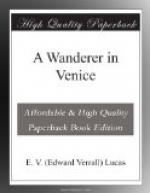And now for the most north-westerly point of the city that I have reached—the church of S. Giobbe, off the squalid Cannaregio which leads to Mestre and Treviso. This church, which has, I suppose, the poorest congregation of all, is dedicated to one of whom I had never before thought as a saint, although his merits are unmistakable—Job. Its special distinction is the beautiful chapel of the high altar designed by the Lombardi (who made S. Maria dei Miracoli) for Doge Cristoforo Moro to the glory of S. Bernardino of Siena. S. Bernardino is here and also S. Anthony of Padua and S. Lawrence. At each corner is an exquisite little figure holding a relief.
On the floor is the noble tombstone of the Doge himself (1462-1471) by Pietro Lombardi. Moro had a distinguished reign, which saw triumphs abroad and the introduction of printing into the city; but to the English he has yet another claim to distinction, and that is that most probably he was the Moro of Venice whom Shakespeare when writing Othello assumed to be a Moor.
The church also has a chapel with a Delia Robbia ceiling and sculpture by Antonio Rossellino. The best picture is by Paris Bordone, a mellow and rich group of saints.
This book has been so much occupied with the high-ways of Venice—and far too superficially, I fear—that the by-ways have escaped attention; and yet the by-ways are the best. The by-ways, however, are for each of us separately, whereas the high-ways are common property: let that—and conditions of space—be my excuse. The by-ways must be sought individually, either straying where one’s feet will or on some such thorough plan as that laid down in Col. Douglas’s most admirable book, Venice on Foot. Some of my own unaided discoveries I may mention just as examples, but there is no real need: as good a harvest is for every quiet eye.
There is the tiniest medieval cobbler’s shop you ever saw under a staircase in a courtyard reached by the Sotto-portico Secondo Lucatello, not far from S. Zulian, with a medieval cobbler cobbling in it day and night. There is a relief of graceful boys on the Rio del Palazzo side of the Doges’ Palace; there is a S. George and Dragon on a building on the Rio S. Salvatore just behind the Bank of Italy; there is a doorway at 3462 Rio di S. Margherita; there is the Campo S. Maria Mater Domini with a house on the north side into whose courtyard much ancient sculpture has been built. There is a yellow palace on the Rio di S. Marina whose reflection in the water is most beautiful. There is the overhanging street leading to the Ponte del Paradiso. There is the Campo of S. Giacomo dell’Orio, which is gained purely by accident, with its church in the midst and a vast trattoria close by, and beautiful vistas beneath this sottoportico and that. There are the two ancient chimneys seen from the lagoon on a house behind Danieli’s. There is the lovely Gothic palace with a doorway and garden seen from the Ponte dell’Erbe—the




